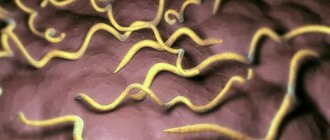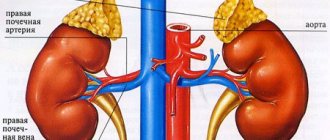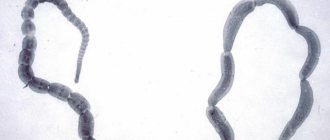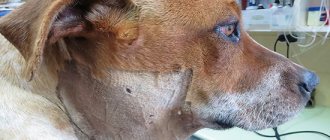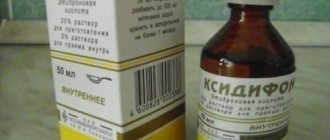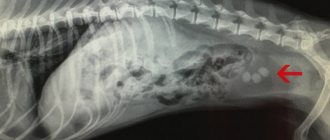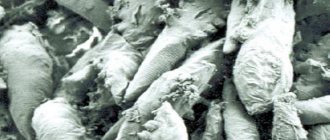Forms of plague and their symptoms
Gastrointestinal form:
- Softening of stool and change in color of stool
Nervous form:
Neurological symptoms depend on the area of the central nervous system affected by viral replication.
- Associated with the meninges: rigidity (a sharp increase in muscle tone, tension) and hypersthesia of the neck muscles (when touched, the neck muscles contract sharply)
- Associated with the cerebellum and temporal lobe: ataxia (impaired coordination of movements), decreased sensitivity of the sensory system (nerve fibers that perceive mechanical forces on tissue (skin)), myoclonus (muscle contractions of one muscle or one muscle group) and convulsions
- Related to the spinal cord: from paresis to paralysis, myoclonus and impaired proprioception (proprioception - muscle sense - the sense of the position of parts of one’s own body relative to each other and in space).
In very young animals with an immature or partially developed immune system, cranial or peripheral neuropathies may be observed, most often optic neuritis occurs.
The observed neurological symptoms range from simple tremor (muscle tremors) to severe syndromes with convulsions.
Neurological symptoms may appear delayed in relation to other symptoms of the disease.
Fatalities associated with canine distemper are typically the result of neurological damage.
Skin form:
- Impetigo (formation of superficial vesicular-pustular rashes): is usually an indicator of a more favorable prognosis of the disease.
- Hyperkeratosis of the nose and footpads (thickening, hardening of the footpads): often associated with neurotropic strains of the virus.
- Neonatal infections: These may be difficult to identify or cause various types of damage. The most common manifestation of these infections is loss of tooth enamel.
Systemic course:
- The most significant damage occurs in the respiratory system, where secondary pneumonia develops
It is important to understand that the division of the disease into separate forms is conditional. Carnivore plague is characterized by multisystem damage to the body.
If your pet exhibits these symptoms, it is recommended to immediately contact the clinic!
If this disease is detected in your animal, urgent treatment and full compliance with the recommendations of the veterinarian are necessary.
Features of the treatment of distemper in dogs
If distemper is detected, treatment of the dog must be started immediately. When treating various forms of the disease, veterinarians adhere to general principles. However, some symptoms can be relieved with additional medications. Some dog owners prefer to combine traditional therapy with folk methods.
Medicines and vitamins
When prescribing treatment for canine distemper, the specialist focuses on the general condition of the dog, its weight and age, and accompanying symptoms. The dosage of medications for an adult dog and a puppy is significantly different. In a clinical setting, the pet is injected with a specific serum, the action of which is aimed at producing distemper antibodies. These include:
- Avirokan. This drug contains antibodies against canine distemper, hepatitis and enteritis.
- Narvak. It contains antibodies from carnivores who have suffered from pathology.
- Biocentre. Has properties similar to the previous drug.
To maintain vitality and eliminate pain symptoms, the animal is injected with solutions of methenamine 40%, ascorbic acid 5%, calcium gluconate 10%, diphenhydramine 1%, glucose and sodium chloride. Treatment of plague includes the use of drugs described in the table.
| Name of the drug | Destination purpose | Release form |
| Prozerin | Prevention and elimination of paresis and paralysis | Solution for subcutaneous administration |
| Mydocalm | Relief from cramps | Tablets, liquid for intramuscular injections |
| Aminazine | Reducing the risk of nervous system damage | Solution |
| Sodium barbital | ||
| Phenobarbital | Elimination of overexcitation | Pills |
| Folic acid | ||
| Novocaine | Pain reduction | Subcutaneous injections |
| Finlepsin | Epilepsy therapy | Capsules with soluble contents |
| Pagluferal | ||
| Antibiotics (Levomycetin, Gentamicin, Claforan) | Secondary infections are treated | Tablets, solutions |
To strengthen the pet's immunity, immunostimulating agents are prescribed. In case of severe vomiting, the dog is given Regidron. The solution is poured 1 tbsp. spoon every 30 minutes. In order to speed up rehabilitation, the animal is given B vitamins, calcium pantothenate, and nicotinamide.
Will folk remedies help?
Before the advent of effective veterinary medicine, dog owners had to treat their pets with traditional medicine. Some people are confident that currently unconventional methods are more effective than pharmaceutical drugs. Most popular recipes:
- Mix 100 ml of vodka with 1 raw egg and 1 tsp. honey Feed the resulting mixture to the dog in two doses. Treatment is continued until the pet's condition improves.
- Pouring cognac into the animal's mouth 2 times a day, 1 tsp.
- Prepare a mixture of 120 g of vodka, 2 minced garlic cloves and 1 egg. Pour the entire mixture into the animal’s mouth using a syringe. Repeat the procedure 2 times a day.
- An injection of penicillin once a day is combined with taking 50 g of vodka mixed with a raw egg every 12 hours.
How to prevent your pet from getting canine distemper
The main method of prevention is vaccination . You can do it at any of our two clinics. The VetMir clinic on Antichny Ave., 18 (+7-978-020-55-51) is open around the clock. Clinic VetMir on the street. Shostak (+7-978-828-34-51) is open from 9:00 to 21:00. For your convenience, we recommend making an appointment at a time convenient for you.
- Maria del Mar Blanco Gutierrez, Jose Antonio Orden Gutierrez, Maria Teresa Cutuli de Simon and others. Immunology and infectious diseases of dogs and cats. 2015 (pp. 60-63)
Prevention of distemper in dogs
The main preventive measure is timely vaccination of the dog against infectious pathologies. The first distemper vaccination is given to puppies at the age of 2 months. After 14 days, the vaccine is reintroduced. Adult dogs receive preventive vaccinations every 12 months. A vaccinated dog can get this disease, but will experience it in a mild form. Other preventative measures include:
- exclusion of contact with stray dogs;
- refusal to meet with dogs who have suffered from the disease in the previous 3 months or are currently being treated;
- strict control over the pet’s behavior during walks (prohibit licking and sniffing feces, plants, drinking water from a puddle);
- periodically washing the dog's bedding in hot water;
- thoroughly wiping paws after walking.
Share with friends!
Plague
Plague is a highly contagious disease that manifests itself as acute pneumonia or lymph node involvement accompanied by fever.
The causative agent of the disease is the plague bacillus.
The plague primarily affects rodents (rats, mice, badgers, squirrels, etc.). Human infection occurs through the bites of fleas infected from sick rodents. The disease is most often transmitted from person to person during outbreaks of pneumonic plague by airborne droplets.
For several millennia, people suffered from plague epidemics, claiming a huge number of lives. At the moment it is very rare, mainly in developing countries.
Treatment consists of taking antibiotics. Without treatment, the patient's risk of death is high.
Synonyms Russian
Black Death.
English synonyms
Plague.
Symptoms
Symptoms of plague depend on its form.
Bubonic plague usually appears 2-5 days after infection:
- a sharp increase in temperature to 40-41 °C, chills and headache;
- buboes - painful, enlarged lymph nodes in the groin, axillary area, in the neck, which are surrounded by an area of edema; approximately in the second week of the disease they may fester;
- muscle pain, severe exhaustion, weakness, abdominal pain, diarrhea.
Septicemic plague occurs when the blood becomes infected with the plague bacillus. The general symptoms are similar to those of bubonic plague, but the buboes themselves are absent.
With pneumonic plague, rapidly progressing symptoms appear 2-3 days after infection:
- high body temperature, weakness, headache;
- cough with bloody or purulent sputum;
- chest pain, difficulty breathing;
- nausea and vomiting.
General information about the disease
Plague is a highly contagious disease that affects the lungs or lymph nodes and is accompanied by fever.
The causative agent of the disease is the plague bacillus.
People have suffered from plague epidemics for several millennia; previously, up to 100% of the inhabitants of infected places died. At the moment it is rare, usually in developing countries.
Initially, the plague affects rodents (rats, mice, rabbits, chipmunks, badgers, squirrels, shrews, etc.). A person becomes infected through the bites of fleas whose owner was previously an animal infected with plague.
In addition, you can become infected from the bites and scratches of cats, when cutting animal carcasses, by airborne droplets from humans during epidemics of pneumonic plague, from animals by inhaling infected airborne particles.
Once the bacteria enters the body with a flea bite, they migrate to nearby lymph nodes and multiply inside the cells. This is how the affected lymph nodes turn into buboes. Then the destruction of the structure and death of the tissue of the lymph nodes occurs. Without treatment, the infection can spread to other organs.
There are three most common forms of plague.
- Bubonic plague is the most common form. Lymph nodes are affected, most often one. With adequate treatment, the mortality rate from bubonic plague is about 20%. The patient is not contagious to others.
- Septicemic plague is a less common form. The patient's blood becomes infected. Buboes are not formed. With full treatment, the mortality rate among patients is approximately 25%.
- Pneumonic plague is a rare form of the disease that affects the lungs. When providing medical care to patients, the mortality rate from pneumonic plague reaches 50%.
Plague can lead to the following complications:
- meningitis - inflammation of the membranes of the brain and spinal cord;
- gangrene (blood clots in the blood vessels of the fingers, formed during the plague, can disrupt the blood flow to them and lead to the death of the limbs);
- septic shock, a life-threatening condition characterized by extremely low blood pressure;
- death (without treatment, the mortality rate from plague is approximately 60%).
Who is at risk?
The risk of getting the plague is quite low. The risk group includes:
- persons who have been in contact with a sick animal or person;
- those who are often bitten by fleas;
- living in areas where there have been outbreaks of plague;
- people whose food may be accessible to rodents;
- residents of areas with poor sanitation and high rat populations;
- those in contact with the plague bacillus by occupation (scientists, doctors, veterinarians).
Diagnostics
If plague is suspected, material is immediately taken from the affected organs and blood, and a chest x-ray is performed. Treatment begins before the test results are available.
- Examination under a microscope of smears from sputum, blood, and affected lymph nodes. Using a special staining of the smear, the bacteria that cause plague (Yersinia pestis) are visually identified. To confirm the diagnosis, it is enough to detect at least one pathogen.
- Culture of blood, sputum, fluid from the lungs, and lymph nodes for plague. The study involves placing the discharge in a nutrient medium, where bacteria begin to multiply and become available for visual assessment. The growth of the plague bacillus in a nutrient medium occurs slowly.
- Examination of a smear using immunofluorescence. During this study, labeled antibodies (molecules that specifically bind to the plague bacillus) are added to the resulting material. Under the influence of ultraviolet radiation, a complex of bacteria “combined” with antibodies gives a characteristic greenish glow, which indicates the presence of a plague bacillus in the taken material. The method is used for rapid diagnosis of plague, having a relatively high specificity.
- Determination of antibodies to the causative agent of plague. When the body is infected with plague, the patient’s immune system begins to produce specific molecules to fight the infection. The amount (titer) of antibodies increases significantly within 2-3 weeks after infection and decreases over several months or years.
- Determination of plague bacillus DNA using polymerase chain reaction (PCR). The method is based on identifying the genetic material of the plague bacillus in the material being studied.
- Identification of the genetic material of the plague bacillus in the studied material.
In order to assess the general condition of the patient and the condition of vital organs, the following tests are performed.
- General blood analysis. Plague is characterized by a significant increase in the level of leukocytes. The platelet level may be reduced.
- Alanine aminotransferase (ALT) and aspartate aminotransferase (AST). Levels of these liver enzymes may be elevated in a significant number of patients with plague, reflecting liver involvement.
Other research methods
- X-ray of the chest organs. With plague, X-rays may show dark spots in both lungs.
Treatment
If plague is suspected, immediate treatment is carried out. Patients with the bubonic form undergo standard isolation. Pneumonic plague requires placing the patient in a special isolation room with air filtration. Treatment and diagnostic procedures are carried out by doctors in special anti-plague suits.
High doses of antibiotics are used. Symptomatic treatment is also carried out. The patient is isolated and treated with powerful antibiotics (streptomycin, gentamicin, doxycycline, etc.).
Prevention
- There is an anti-plague vaccine. However, it has not been sufficiently tested and does not protect against pneumonic plague.
- When in natural plague foci, it is necessary to take antibiotics to prevent the disease.
- Near places where people are located, it is important to remove all potential nesting sites for rodents: landfills, garbage, firewood, etc. It is advisable to leave pet food out of the reach of rodents.
- Pets should be checked regularly for fleas.
Recommended tests
- General blood analysis
- Alanine aminotransferase (ALT)
- Aspartate aminotransferase (AST)
Additional Information
- Dan L. Longo, Dennis L. Kasper, J. Larry Jameson, Anthony S. Fauci, Harrison's principles of internal medicine (18th ed.). New York: McGraw-Hill Medical Publishing Division, 2011.
